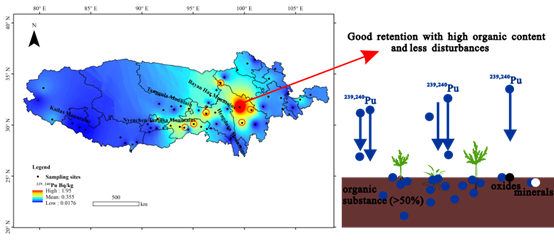Sources, Distribution, and their Environmental Behaviors of Plutonium Isotopes in the Qinghai-Tibet Plateau Revealed
Large amounts of anthropogenic radionuclides have been released into environment through atmospheric nuclear weapons tests, nuclear accidents, nuclear fuel reprocessing, etc., which leads to the significant increase of environmental radioactivity level.
Due to the high radiotoxicity in high concentration of α emitting 239Pu (T1/2 = 24,100 yr) and 240Pu (T1/2 = 6561 yr), and the fingerprint information of source terms carried by 240Pu/239Pu atomic ratios, the level and sources of 239,240Pu in the environment is of great significance in the view of radiation risk. Meanwhile, the environmental behaviors, including deposition, retention and migration of plutonium are also important in the investigation of their potential hydrosphere contamination, uptake by flora and fauna and transfer to food chain.
However, such research in the Qinghai-Tibet Plateau is still missing, where is deemed as an environmental sensitive area. Researchers from the environmental radioactive team in the Institute of Earth Environment, Chinese Academy of Sciences collected surface soil samples from the Qinghai-Tibet Plateau and first analyzed 239,240Pu concentrations and 240Pu/239Pu ratios in this area.
They found that the concentrations of 239,240Pu were in the range of 0.0176–1.95 Bq/kg, falling into the reported ranges in the background areas from the similar latitude belt. The 240Pu/239Pu atomic ratio range was measured to be 0.146–0.225, which was similar with the global fallout values. Both indicate that the stratospheric fallout from global atmospheric nuclear weapons tests is the major radioactive source in this region, and the low plutonium level will not cause any radiation risk so far.
Based on the statistical analysis of all the possible parameters influencing the spatial distribution characteristics of 239,240Pu concentrations, including soil organic content, soil moisture content, average annual precipitation, altitudes, topography and human activity, the large variations of 239,240Pu concentrations were mainly attributed to the retention process related factors including soil organic content and human activity disturbances. While, the deposition related factors including the average annual precipitation, altitudes, topography made insignificant influence due to the low 239,240Pu concentrations in atmosphere, less wet deposition amount and low re-suspended amount. The highest 239,240Pu concentrations of 0.805–1.95 Bq/kg were mainly due to the good retention condition in the sampling sites with higher soil organic content and less human activity disturbances.
This work, published in Environmental Pollution, was financially supported by the Chinese Academy of Sciences (No. XDB40020100, 132B61KYSB20180003), the Natural Science Foundation of China (No. 41991252, 11875261), and the State Key Laboratory of Loess and Quaternary Geology (No. SKLLQG1942).

Fig. Spatial distribution of 239,240Pu concentrations in the Qinghai-Tibet Plateau with high values and their formation mechanisms (Image by ZHAO, et al)
Contact: Bai Jie, Institute of Earth Environment, Chinese Academy of Sciences, Xi'an, China. Email: baijie@ieecas.cn
 © 2015 Institute of Earth Environment,CAS
© 2015 Institute of Earth Environment,CAS Address:No. 97 Yanxiang Road, Xi'an 710061, Shaanxi, China

 Location :
Location :